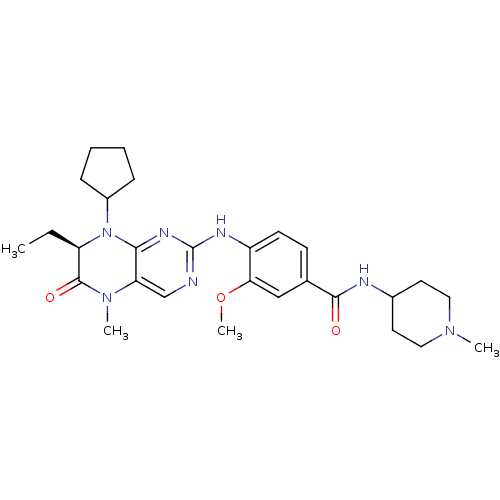TargetALK tyrosine kinase receptor(Homo sapiens (Human))
The Institute Of Cancer Research
Curated by ChEMBL
The Institute Of Cancer Research
Curated by ChEMBL
Affinity DataIC50: 180nMAssay Description:Displacement of kinase tracer 236 from human N-terminal GST-tagged ALK F1174L mutant (1058 to 1620 residues) after 60 mins by LanthaScreen Eu--kinase...More data for this Ligand-Target Pair
TargetALK tyrosine kinase receptor(Homo sapiens (Human))
The Institute Of Cancer Research
Curated by ChEMBL
The Institute Of Cancer Research
Curated by ChEMBL
Affinity DataIC50: 390nMAssay Description:Inhibition of ALK (unknown origin)More data for this Ligand-Target Pair
TargetALK tyrosine kinase receptor(Homo sapiens (Human))
The Institute Of Cancer Research
Curated by ChEMBL
The Institute Of Cancer Research
Curated by ChEMBL
Affinity DataIC50: 890nMAssay Description:Inhibition of full-length C-terminal NanoLuc-tagged ALK (unknown origin) expressed in human HEK293 cells after 2 hrs by NanoBRET target engagement as...More data for this Ligand-Target Pair
TargetALK tyrosine kinase receptor(Homo sapiens (Human))
The Institute Of Cancer Research
Curated by ChEMBL
The Institute Of Cancer Research
Curated by ChEMBL
Affinity DataIC50: >9.40E+3nMAssay Description:Inhibition of ALK F1174L mutant auto-phosphorylation in human Kelly cells after 3 hrs by MSD assayMore data for this Ligand-Target Pair
TargetALK tyrosine kinase receptor(Homo sapiens (Human))
The Institute Of Cancer Research
Curated by ChEMBL
The Institute Of Cancer Research
Curated by ChEMBL
Affinity DataKd: 160nMAssay Description:Binding constant for ALK kinase domainMore data for this Ligand-Target Pair

